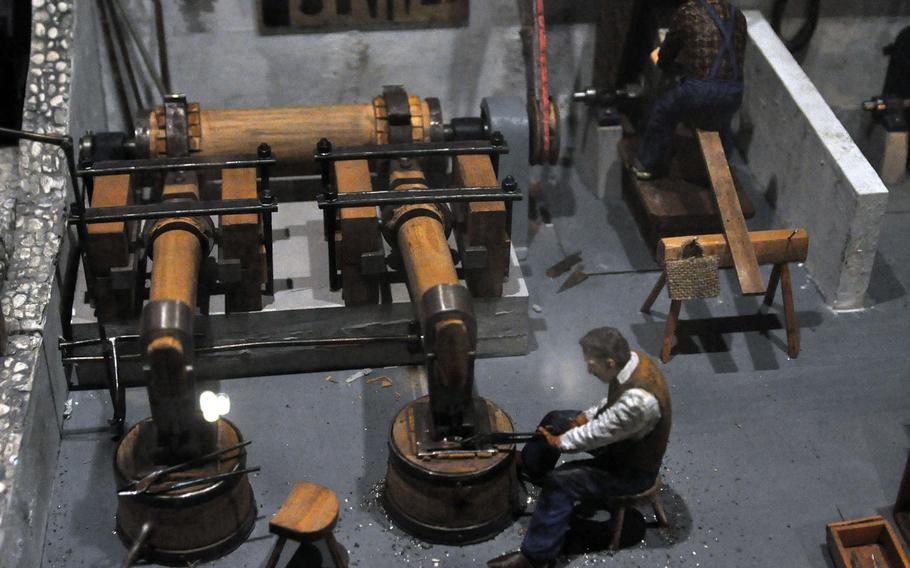
A display featuring miniature figures using equipment to make knives the way they were produced in the 15th Century is one of the first things for visitors to the Museo dell'Arte Fabbrile d delle Coltellerie in Maniago, Italy. (Kent Harris/Stars and Stripes)
If you’re someone who just uses a knife to cut up steak or spread peanut butter, Maniago’s top tourist attraction might not hold much interest.
If, however, you grew up with a favorite pocket knife, or fancy yourself an Iron Chef, Museo dell’Arte Fabbrile e delle Coltellerie is at least worth a few hours of your time.
It’s the Museum of Manufacturing Art. So it isn’t technically just about knives. There are more than a few scissors, shears and other things metal and pointy.
But in a place that refers to itself as “City of Knives,” the focus is fairly clear.
Maniago has been known for its knives for more than 650 years. Documentation dates back to 1453 when a license was requested to operate a factory using water power. The availability of running water was the primary reason the site was chosen. Despite its location at the foot of the Dolomites, known to most as the Alps, the raw materials mostly had to be imported from Austria and Germany.
In the early days, that factory — and others that came after — concentrated on equipment for agriculture and armaments for the Republic of Venice. But over the centuries, specialties developed and business grew.
Today, there are about 60 businesses of varying sizes in the city that produce at least some components of table knives, hunting knives, scissors, pruning shears or cheese spreaders.
The museum itself, which opened in 2009, is located in a factory that opened in 1907 and closed in 1972. The first floor features several rooms of original knife-making equipment pulled from local factories. Some of it looks like it could be used today, though much of it is older than any of the visitors to the museum. There is also a gift shop where visitors can spend a few — or a few hundred — euros on knives. They’ve also got brochures and information on other places in town to buy knives or even get one custom made.
The second floor features a movie (in Italian only) and dozens of small glass display cases featuring scissors, dental equipment, garden implements, farm equipment, and, of course, knives. Some of the knives look like they were made for a horror movie, though many others are finely crafted and were obviously intended more for display than use. Ever hear of a mushroom knife? There’s seemingly a knife for every purpose.
Descriptions on the display cases in both Italian and English explain a bit about the implements or their history. Did you know that table knives were virtually nonexistent before the 13th century? Food either came to the table precut or diners pulled the knives from their belts and stabbed away.
Museo dell’Arte Fabbrile e delle Coltellerie
DIRECTIONS
Address: Museo dell’Arte Fabbrile e delle Coltellerie, Via Maestri del lavoro 1, Maniago, Italy
Directions: The museum is about a 20-minute drive from Aviano Air Base. Take Via Maniago over the one-way bridge that passes through Vajont; continue on Via Pordenone, turning right on Via Vittorio Emanuele, then right on Via Maestri del Lavoro d’Italia. Or take the SP19 that crosses the larger bridge to the north, follow Via Marco Polo until it ends; turn left onto Via Unita D’Italia (the SR464) and left again onto Via Vittorio Emanuele and take an immediate left.
TIMES
The museum is open from 9:30 a.m. to 12:30 p.m. daily and 3:30 to 6:30 p.m. Thursday through Monday.
COSTS
A standard ticket is 4 euros (about $4.40) for adults; 2 euros for children, groups of 10 or more and those over 60. Tours in English should be booked ahead and could cost more.
FOOD
There’s no cafe in the museum. But there’s a small shopping center adjacent to it and lots of options just a few minutes away in the downtown area.
INFORMATION
Visit www.turismofvg.it/Museums/Museum-of-manufacturing-art (in Italian and English). Phone: (+39) 0427-709063 (some English spoken). Email: coricama@maniago.it. Call or email at least a week in advance to book a tour in English.